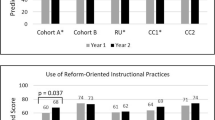Abstract
Instructional development has been a recent innovation in higher education, responding to the needs of the new American model of universal higher education. Misconceptions and misapplications of instructional development have been frequent, especially its confusion with media service. A fundamental obstacle to success in any instructional improvement program is hypothesized to be lack of concern with faculty attitudes in the planning of methods to serve them. This study discusses the background of the problem and reports on a survey designed to investigate faculty attitudes toward instructional development on one campus. Tentative conclusions are drawn in order to guide further study. The data presented appear to indicate that there is a need to rethink the basic model of instructional development as currently used when applying it to the unique circumstances of higher education.
Similar content being viewed by others
References
Barzun, J. (1970). “The American University.” New York: Harper and Row.
Briggs, L.J. (1970). “Handbook of Procedures for the Design of Instruction.” Pittsburg: American Institutes for Research.
Caplow, T., and McGee, R.J. (1958). “The Academic Marketplace.” New York: Doubleday.
Carnegie Commission on Higher Education (1972). “The Fourth Revolution: Instructional Technology in Higher Education. New York: McGraw-Hill.
Carnegie Commission on Higher Education. (1973). “Priorities for Action: Final Report of the Carnegie Commission on Higher Education.” New York: McGraw-Hill.
Diamond, R.M., Eickmann, P.E., Kelly, E.F., Holloway, R.E., Vickery, T.R., and Pascarella, E.T. (1973). “Instructional Development in Higher Education.” Syracuse, N.Y.: Syracuse University.
Evans, R.I. (1968). “Resistance to Innovation in Higher Education.” San Francisco: Jossey-Bass.
Hoban, D. (1974). The instructional developer. AV Communication Review 22:453–466.
Kerr, C. (1964). The frantic race to remain contemporary. Daedalus Fall, pp. 1051–1070.
Riesman, D., Gusfield, J., and Gamson, A. (1971). “Academic Values and Mass Education.” New York: Doubleday.
Spitzer, D.R. (1975). Commitment to instructional development. Paper presented at the Conference on University Applications of Cable/Satellite Technology, Madison, Wisconsin, June.
Stogdill, R.M. (1966). Dimensions of organizational theory. In “Approaches to Organizational Design” (Thompson, J.D., ed.). Pittsburg: University of Pittsburg Press, pp. 1–56.
Stowe, R.A., and Schwen, T.M. (1973). Varieties of analysis in instructional development. AV Communication Review 21:5–10.
Trow, M. (1970). Reflections on the transition from mass to universal higher education. Daedalus Winter, pp. 1–42.
Wilcox, J. (1968). “A Survey Forecast of New Technologies in Universities and Colleges.” Cambridge, Mass.: Alfred P. Sloan School of Management, M.I.T.
Author information
Authors and Affiliations
Rights and permissions
About this article
Cite this article
Spitzer, D.R. The importance of faculty attitudes in the planning for instructional development. Res High Educ 5, 97–111 (1976). https://doi.org/10.1007/BF00992005
Issue Date:
DOI: https://doi.org/10.1007/BF00992005



